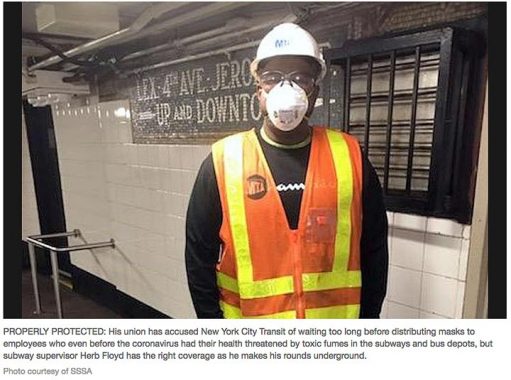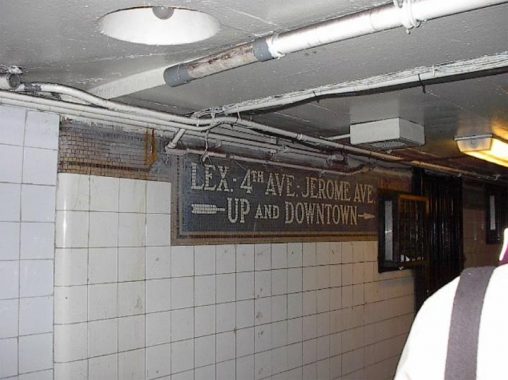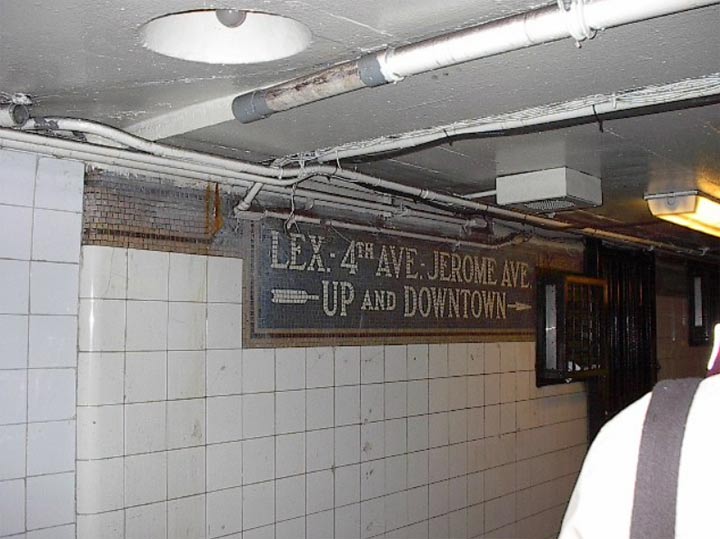A couple of weeks ago, I wrote about the tile directional sign at the East 149th Street station in the Bronx pointing to a nonexistent stop on the NY Central (now Metro-North) line. In Comments, some readers speculated that since there was a large trainyard a couple of blocks away at the tracks, the sign was meant to direct railroad workers. While scanning the internet today, I found another seemingly out-of-time mosaic sign in the same station, which has been something of a treasure trove of subway artifacts.

I found it in this article in The Chief (which serves civil service workers) about how subway workers have inadequate Covid-19 protections. The MTA worker is standing in a corridor at the East 149th Street station that transfers riders between the #2 and 5 trains with the #4. Here, the #5 diverges from the #4 (i.e., the Lexington Avenue line) and buddies up with the #2 up to the East 238th Street station. At 149th, riders can transfer to the #4, which goes on the Jerome Avenue line to Woodlawn Cemetery.

It’s that marvelous mosaic sign that directs riders to what is now just the #4 train. Before the MTA settled on its present nomenclature of numbered and lettered trains beginning in the 1930s with the advent of the IND (the IRT and BMT had their own individual sets of numbered trains, until the BMT got its own set of letters in the 1960s) lines were known by the streets they ran under, like the Broadway Line, the 7th Avenue Line, the Lexington Avenue line etc.
The Lexington Avenue Line is today’s #4, 5, and 6 in Manhattan. Trains ran beneath Lexington Avenue and switched to 4th Avenue (now Park Avenue; it’s complicated) south of Grand Central Terminal on East 42nd. Of course, trains ran on an elevated line above Jerome Avenue in the Bronx.
The sign is notable because the MTA is fairly “Nazi” about replacing older signage with modern signage, i.e., the black metal signs with white Helvetica type. This sign should be covered with a black sign with arrows and a green 4 bullet, but thankfully at the moment it’s not.

I recently acquired a font replica that was designed for the subway mosaic signs of the early 20th Century. This particular font was used in the BMT stations and isn’t an exact match for the IRT, but it’s pretty close. I don’t have the expertise to match the actual mosaic plaques, and the font doesn’t have arrows as far as I know, but it’s a fairly good match, no?
Check out the ForgottenBook, take a look at the gift shop, and as always, “comment…as you see fit.”
4/21/20


2 comments
The reason why IRT trains “ran beneath Lexington Avenue and switched to 4th Avenue” is not an accident. Begin with the original IRT Contract 1 subway, which ran from City Hall (adjacent to today’s Brooklyn Bridge Station) northward under Lafayette St. (originally Elm Street) and then 4th Avenue as far as 42nd Street. The trains then swung 90 degrees to the left at Grand Central and traveled under 42nd Street to Times Square, and then turned north to two eventual terminals in The Bronx (242nd St. and 180th St.-Bronx Park). Most of these routes began operating in 1904, except for the portion along Broadway between 157th and 242nd Streets which opened 1906-08.
In 1913 NY City government commissioned a vast expansion of the then-nascent subway system, know as the Dual Contracts (officially Contracts 3 and 4). Part of this expansion were two new IRT trunk lines in Manhattan, below 7th Avenue and Varick Street south of Times Square, and below Lexington Avenue north of Grand Central. The idea was to create two parallel IRT trunk lines the length of Manhattan that would tie into new routes in The Bronx and Brooklyn. North of Grand Central, the new IRT tunnel jogged one block east to Lexington Ave., because Park Avenue, of course, already hosted the NY Central (now Metro North) tracks. That’s why the IRT Lexington tunnel is angled under Grand Central, because the tunnel connects Lexington and Park (formerly 4th) Avenues. Today’s #4-5-6 trains were once called the Lexington-4th Avenue line, but that terminology is long outdated. Here’s a link to an official 1948 Board of Transportation subway map that simply used “Lexington Ave. Line” to name the East Side IRT. It’s from website http://www.nycsubway,org. https://www.nycsubway.org/perl/caption.pl?/img/maps/system_1948_routeinfo.gif
Technically, the Lexington Avenue Subway was the part from Grand Central north, and the Seventh Avenue Subway was the part from Times Square south. Those were the new parts in 1918.
It seems as if someone wanted to help riders understand which parts of the old subway were involved in the new routings, thus Lexington-Fourth and Broadway-Seventh.
It’s interesting that the term Broadway-Seventh Ave hung on until the Chrystie Street rebranding with letters and numbers while Lexington-Fourth dropped out of use much longer ago.